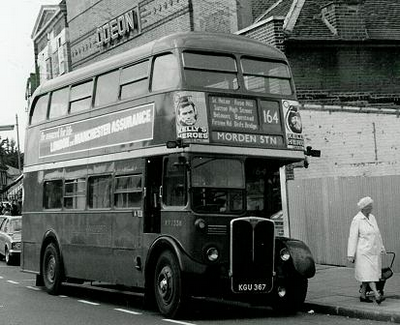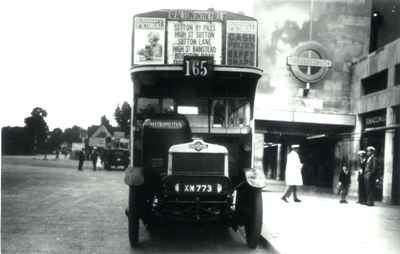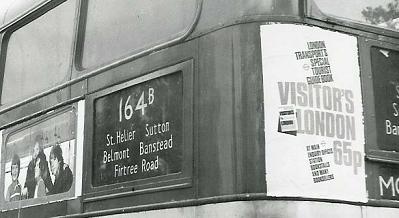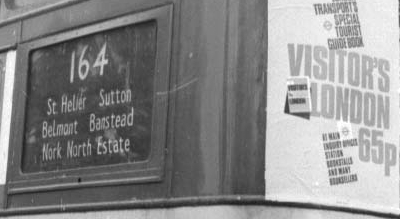 Worcester Park 2008 Worcester Park 2008
Route 164
Route
MORDEN STATION to EPSOM via St Helier Ave, Sutton and
Banstead.
Timetable
Buses will run an infrequent service over the full route,
with additional short workings. The revised timetable
is attached.
Main boarding points
Morden Station stop H, St Helier Avenue Middleton
Road,
Sutton Green stops A and B,
Sutton Library stop V, Post Office stop R and
Police Station stop K, Epsom Clock
Tower.
Morden Station feeder
service 164 ran from Morden to Epsom via Sutton from 1930, when it
ceased serving North Cheam, until 1982. The route was
operated by Sutton RTs for many years, such as newly-overhauled
RT2338 seen in front of the Epsom Odeon.
Photo © John Parkin
Route history
Introduced in 1926 as one of the feeders to the new
Underground station at Morden the early 164 ran to Burgh Heath via
North Cheam and Ewell, then two years later was double-decked and
diverted at Drift Bridge to run in a circle back to Morden via
Sutton.
May 1930 saw a further change, with the adoption of the route
that remained unchanged for over 50 years, apart from small
diversions for one-way systems. This ran from Morden direct
to Sutton, then in a large loop via Banstead and Drift Bridge to
Epsom.

The initial single-deck Ks were replaced by S-types, then in
1931 by NSs. These were replaced by STLs in 1935-6, remaining
until the arrival of Sutton's Daimlers in 1946.
The 164A, Morden to Tattenham Corner, deserves a
mention, as it started life in 1927 as the well-known race-day
service to Epsom Downs from Morden. These services were
renumbered 131 from 1930, but the 164A reappeared in its
Tattenham Corner guise in 1935. It lasted virtually unchanged
until withdrawal in 1979.
Route 165 and its diminutives became the
164A in 1934. As well as the rare glimpse of
the expanse of Morden's forecourt in 1930 behind S569, the picture
is of interest because the route then ran via Banstead to
Walton-on-the-Hill, better known as the destination of the
80A.
Photo from W Noel Jackson collection, ©
Alan Cross
From 1950, the 164 schedules (already joint with the
164A) were compiled jointly with the 156, as the strong demand for extra workings
between St Helier and Sutton Common Road on the latter route meant
that union limits on the number of spread-over workings would have
been breached had that route continued to stand alone.
Conversion from D to RT was completed in December 1953, In
1961, Sutton Garage was joined on Mondays to Fridays by a small
allocation from Merton, and it was this allocation that first
converted to RM in 1973. Weekend conversion followed in 1976
and the route was entirely RM by January 1977.
OMO conversion to DMS coincided with withdrawal of the
164A in 1979. Changes to the route started in 1982
and the route first reached Wimbledon in 1984. The present
day routing between Wimbledon and Sutton commenced in 1991, with
the route converting to single-deck in 1996.
Postscript
I'm sure connoisseurs will appreciate the
following item from The Omnibus Magazine, December 1961
(© The Omnibus Society):

'A London Transport service that has yet to
earn its place in our Around the Traffic Areas feature is
the 164B. This should have been introduced on
October 11th [1961]. In the spring of this year,
people in the Nork area of Banstead, which lies to the south of Fir
Tree Road, held a referendum to see if they wanted a bus service
through their area.  The LTE had already
twice rejected an application from Banstead Coaches Ltd to extend
their service from Woodmansterne to cover part of Nork Way. A
majority favoured the provision of such a service and the result
was sent to the LTE, to Banstead Coaches, to Banstead Urban
District Council and to the local police, without any
comment. In the middle of September, London Transport
announced that as from October 11th, service 164 was to
be diverted at Drift Bridge (Reigate Road, Fir Tree Road) via
Reigate Road and Nork Way and so back to Fir Tree Road near
Banstead Station. A new service, the 164B, would
run direct via Fir Tree Road (as the present 164) during rush hours
only. The terminal points of this route seem to be
obscure. The residents of Nork Way then protested that their
referendum had not been a mandate for the LTE to operate a regular
20-minute service of red double-deckers along their quiet,
residential road. This was a totally different thing from the
“candyfloss” service of Banstead Coaches that they had voted
for. London Transport have agreed to postpone the new
services until a new referendum has been held to see if the
residents want the 164 or not. In these politically troubled
days, it all sounds too much like democracy to be true.' The LTE had already
twice rejected an application from Banstead Coaches Ltd to extend
their service from Woodmansterne to cover part of Nork Way. A
majority favoured the provision of such a service and the result
was sent to the LTE, to Banstead Coaches, to Banstead Urban
District Council and to the local police, without any
comment. In the middle of September, London Transport
announced that as from October 11th, service 164 was to
be diverted at Drift Bridge (Reigate Road, Fir Tree Road) via
Reigate Road and Nork Way and so back to Fir Tree Road near
Banstead Station. A new service, the 164B, would
run direct via Fir Tree Road (as the present 164) during rush hours
only. The terminal points of this route seem to be
obscure. The residents of Nork Way then protested that their
referendum had not been a mandate for the LTE to operate a regular
20-minute service of red double-deckers along their quiet,
residential road. This was a totally different thing from the
“candyfloss” service of Banstead Coaches that they had voted
for. London Transport have agreed to postpone the new
services until a new referendum has been held to see if the
residents want the 164 or not. In these politically troubled
days, it all sounds too much like democracy to be true.'
John Parkin happened to find
RT2875 at Tattenham Corner in 1976, carrying a side blind
for the route that never was and for the diversion that never
operated.
Needless to say, the 164B never did materialise, but
I don't know whether the residents ever got their Banstead Coaches
service. Does anyone know? Incidentally, whilst we are
unable to offer a Banstead Coaches service, former Surrey Motors
and Epsom Coaches coaches will be providing tours from North
Cheam.
|